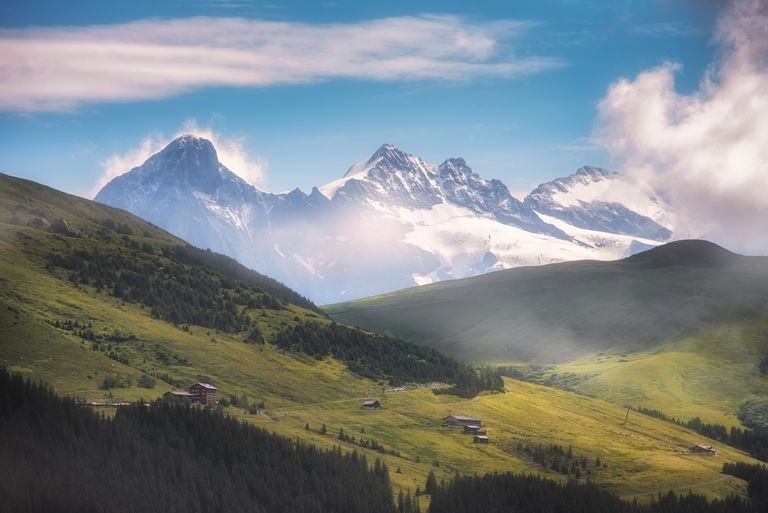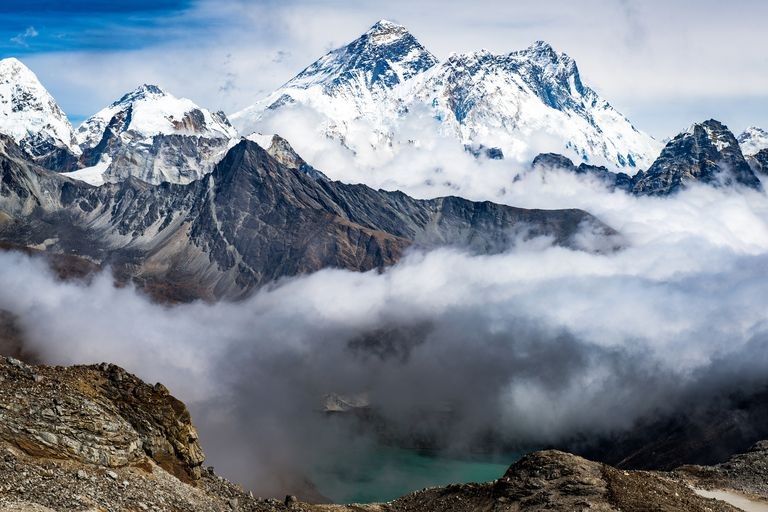Recently, the Swiss Alps made the news when scientists found they were growing due to tectonic activity deep beneath Earth’s surface. Now, Mount Everest is also on the rise. Why is there so much “mounting” altitude?
Strangeness in the Alps

In the case of the central Alps, the situation is scientifically complex. First, a rapid review of the basics of plate tectonics: Earth is basically a floating ball of slick magma with a thin candy shell of crust around the outside. The crust is broken into large parts, and these parts continue to push into and crunch away at each other.
This causes different things — not just earthquakes and volcanoes, but also continental drift and the consequent destruction and recreation of crust. Deep within the Atlantic Ocean, new ocean floor emerges every day as the two sides are pushed apart. On the other end, ocean floor collides with and is pushed beneath the continental plates.
So imagine filling your bathtub with cold water and then dropping in enough big chunks of ice to fill the surface and then some. The chunks will start to push each other and rise and fall. This is exactly what happens in the crust, and it’s why the Alps are still growing.
It’s called crustal uplift, crustal uprise, tectonic uplift—all terms that refer to the same idea. And after thinking about how Earth’s crust roams and interacts, it’s easy to see why deciding how to measure the height of these mountains is itself a challenging problem.
In this case, any crustal uplift is working against the related up-top phenomenon of erosion. The Alps are, cosmologically speaking, just babies compared to many of the world’s oldest mountain ranges. Because of that, they’re still spiky and jagged, extremely tall, and subject to high rates of erosion at their peaks.
Scientists have long believed the Alps are basically shifting in place like an escalator: uplifted by the crust and eroded from the top at the same rate. They can use chemical signatures made by bouncing cosmic radiation to estimate how much of what’s visible at the very top of a mountain is very old and, therefore, the result of erosion of the newer rock over top—like the shiny nose on a much-beloved local statue rubbed for good luck.
“As cosmic rays hit Earth’s surface, oxygen atoms that constitute quartz minerals experience a nuclear reaction,” scientists from Bern University explain in a statement. “[A] new isotope is formed. Because [it’s] only formed on Earth’s uppermost surface, the surface age can be determined with this isotope. If the concentration is high, then the surface has been exposed to cosmic rays for a relatively long time and is therefore relatively old.”
The scientists found that erosion is slower than crustal uplift, especially in Switzerland, where the Alps erode at an astonishing 14 millimeters per 1,000 years. Uplift, on the other hand, can be as high as 800 millimeters during the same time frame. These parts of the Alps are racing upward more than 50 times faster than they’re sanded down.
Understanding the difference can help scientists make more accurate measurements of other phenomena, including in detailed studies of why and where erosion happens the most.
Meanwhile, on Mount Everest

The situation for Everest is very different. High in the Himalayan Mountains, Everest and K2 are just the two highest peaks of an astonishing series of mountain ranges that encompass 2.5 million square miles of elevated land in the Tibetan Plateau.
And because Everest sits on a contested boundary between Nepal and China, measuring it in any way immediately becomes a matter of politics. It’s here, rather than in the simple bump and grind of crust and erosion, that Everest has gained 30 feet overnight.
International politics aren’t the only politics involved. Everest is a multimillion-dollar business in an area where that money is critically needed. Measuring the world’s tallest mountain to an exact number has significance to the entire industry that has sprung up around climbing it, rescuing people from it, and caring for the terrain.
Do you measure the snow at the very top, or do you count the highest rocky point? And when the summit spans two nations that don’t have a great relationship, whose measurement counts more?
The first measurement was made in the 1850s, and Nepal’s penultimate measurement dated back to the 1950s. China was working with a much newer number, but there was a catch, the New York Post reports:
“China and Nepal announced Tuesday that it is officially 29,031.7 feet tall. That is 13 feet higher than China’s last calculation 15 years ago — a discrepancy blamed on the fact that China only determined the rock height of the summit and didn’t include the snow and ice on the peak.”
There has never been a single measurement that both nations agreed to, which makes this new one a similar political milestone, or more of a 5.5-milestone. Leaders from China and Nepal pressed matching buttons to reveal the official height of Everest. And to bring the two ideas together, the entire Himalayan range was formed by the subduction — the pushing under — of a previously major and separate tectonic plate.
Of course, the next step is to find how quickly Everest is growing and eroding. The Himalayas are one of the other youngest ranges on the planet, meaning there could be some very interesting isotopes to take a look at for those who reach the very top. [PM]
Now subscribe to this blog to get more amazing news curated just for you right in your inbox on a daily basis (here an example of our new newsletter).
You can also follow us on Facebook and/ or Twitter. And, by the way you can also make a donation through Paypal. Thank you!
You should really subscribe to QFiles. You will get very interesting information about strange events around the world.














After Pele/Martinique, Vesuvius, 3 months later west coast is wet coast.
I still believe in the “Expanding Earth Theory”, with all of its perturbations being just part of it growth spurts. IE: Volcanoes are just “Zits” and earthquakes are its tantrums.
Ok, I expect Mauna Loa is the true tallest mountain in the world. I expect with MT. Everest getting a few feet added Pele will cause and eruption to add a few more feet to her home.